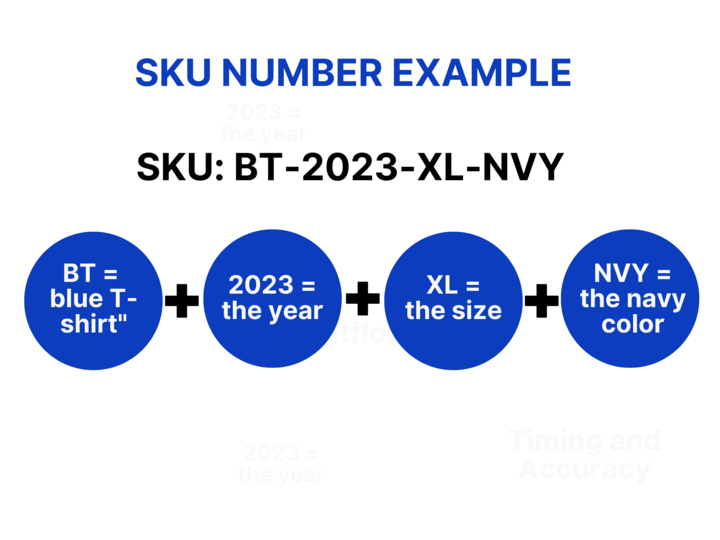In today’s retail and ecommerce landscape, managing inventory can be a complex and time-consuming task. With the increasing demand for online shopping, ecommerce businesses must have efficient and effective ways to keep an eye on their inventory, analyze sales data, and streamline their operations. One of the most crucial elements of effective inventory management is having a system in place to accurately track and identify products. That’s where SKU numbers come in.
In this article, we’ll explore what SKU numbers are, how they work, and why they’re crucial for effective inventory management. Whether you’re starting a new business or managing an existing one, understanding SKU numbers is important for running your business, reducing errors, and meeting your customers’ needs. So, let’s dive in and learn more about SKU numbers and how they can benefit your business.
Contents:
5. How is SKU used in business?
6. Tools and software for managing SKU numbers
9. Best practices for managing SKUs
What is a SKU number?
The abbreviation SKU is short for Stock Keeping Unit – a unique alphanumeric code assigned to each product in a retailer’s inventory. This code includes information about the distinctive features of a product. Retailers use SKU numbers for identifying and managing individual products.
The components of a SKU number vary from business to business, but typically include from 8 to 12 characters representing the product type, size, color, and its other unique features.
SKU number example

A SKU is a unique identifier for a specific product in a retailer’s inventory. SKU numbers are typically used to track and manage inventory and can vary widely in format depending on the retailer or organization’s specific needs. Here’s an example of SKU logic:
Let’s say you work for a clothing retailer, and you have a blue t-shirt in your inventory. The SKU number for this t-shirt might look something like this:
SKU: BT-2023-XL-NVY
In this example:
- “BT” could stand for “Blue T-shirt”, indicating the product category.
- “2023” might represent the year the SKU was created or the year the product was released.
- “XL” could indicate the size of the t-shirt (extra-large).
- “NVY” could represent the color of the t-shirt (navy).
Please note that SKU formats can vary widely, and different companies or industries may use different conventions for SKU numbers. The goal is to create a system that helps efficiently track and manage inventory.
Where to find SKU numbers
SKU numbers can typically be found in several places:
- Product packaging: Many products have their SKU numbers printed on the packaging. Look for labels or stickers with a combination of letters, numbers, and sometimes barcodes.
- Product labels or tags: Some items, especially clothing and accessories, have SKU numbers on tags or labels attached to the product itself.
- Receipts and invoices: When you purchase a product, the SKU number is often included on the receipt or invoice. It’s a helpful reference for returns or exchanges.
- Online retailer websites: If you’re shopping online, the product’s SKU number is often listed in the product description or details section. You may also find it on the order confirmation page or in your order history.
- Inventory management systems: If you work in retail or manage inventory, SKU numbers are stored in inventory management systems. You can search for SKU numbers within the system to locate specific products.
- Barcode scanners: Retail employees often use barcode scanners to quickly find products and their associated SKU numbers. Simply scan the barcode on the product, and the SKU information is retrieved from the system.
- Product manuals or documentation: In some cases, especially for electronics or appliances, SKU numbers may be mentioned in the product’s manual or documentation.
- Product listings in catalogs: If you’re browsing through a printed or online catalog, SKU numbers are typically associated with each product listing.
Remember that SKU numbers can vary in format and length depending on the retailer or manufacturer. If you’re having trouble finding a SKU number for a specific product, you can often ask a store associate or contact the manufacturer’s customer support for assistance.
Learn more about how to find SKU numbers.
Who needs SKUs
SKUs (Stock Keeping Units) are a valuable tool for various businesses and organizations across different industries. Here’s a breakdown of who needs SKUs:
- Retailers: Retail businesses, whether brick-and-mortar stores or ecommerce platforms, rely heavily on SKUs and retail accounting practices. They use SKUs to manage and track their inventory, streamline the checkout process, and maintain accurate records of product sales and stock levels.
- Manufacturers: Manufacturers use SKUs internally to organize and manage their production processes. They may assign SKUs to components, parts, or finished products to track their manufacturing and supply chain operations efficiently.
- Wholesalers and distributors: Wholesalers and distributors utilize SKUs to manage large quantities of products from various suppliers. SKUs help them keep track of inventory, streamline order fulfillment, and accurately manage stock levels.
- Ecommerce businesses: Online retailers and marketplaces heavily depend on SKUs to manage their vast product catalogs. SKUs help them organize products, facilitate search and navigation for customers, and enable efficient order processing and shipping.
- Inventory managers: Professionals responsible for inventory management in various industries, including logistics, supply chain, and warehouses, rely on SKUs to track stock levels, monitor product movement, and optimize inventory turnover.
- Restaurants and foodservice: Restaurants, cafes, and foodservice establishments use SKUs to manage their food and beverage inventory. This helps them control costs, minimize waste, and ensure menu consistency.
- Healthcare providers: Hospitals, clinics, and healthcare providers use SKUs to manage medical supplies, equipment, and pharmaceuticals efficiently. SKUs assist in maintaining accurate stock levels and ensuring patient care is not disrupted due to inventory shortages.
- Manufacturing and assembly plants: Manufacturing and assembly plants use SKUs to track components, sub-assemblies, and finished products throughout the production process. SKUs aid in quality control and production planning.
- Artists and craftsmen: Even small-scale artists and craftsmen may use SKUs to track their inventory of materials and finished products. This helps them manage their creative endeavors more effectively.
- Event planners: Event planners and rental companies use SKUs to manage equipment and decor inventory for various events, ensuring they have the necessary items available when needed.
- Nonprofit organizations: Nonprofits that distribute goods and supplies use SKUs to manage their inventory efficiently, ensuring that resources are distributed to those in need effectively.
In summary, SKUs are valuable for a wide range of businesses and organizations that deal with inventory management, product tracking, and efficient operations. They are essential for maintaining accurate records, improving efficiency, and ensuring products or resources are available when needed.
How is SKU used in business?
Creating and assigning SKU numbers is a straightforward process. Businesses can create their SKU numbers or use software to generate them automatically. Once the SKU numbers are created, big and small businesses can use them for various purposes:
Inventory management
SKUs are primarily used for inventory management. They provide a unique identifier for each product, allowing businesses to track stock levels, restock products, and prevent overstocking or stockouts. Inventory managers can use SKUs to quickly locate products in storage facilities. SKU numbers help businesses effectively manage their inventory, and as a result drive more revenue. By using SKU numbers, businesses can quickly identify each product in their inventory and ensure that they have the right products in stock at all times. Additionally, SKU numbers facilitate stock replenishment, accurate product identification and categorization, and optimize your inventory operations.
Sales and checkout
In retail settings, SKUs are used during the checkout process. Cashiers can scan the product’s barcode, which typically contains the SKU, to retrieve pricing information and add the product to the customer’s bill. This speeds up transactions and reduces errors.
Order fulfillment
Ecommerce businesses and warehouses use SKUs to pick and pack orders accurately. When an order is received, the SKU helps identify the exact product to be included in the shipment.
Product Identification
SKUs are used to uniquely identify products. This is especially important when multiple products have similar names or descriptions. SKUs ensure that the right product is selected and shipped.
Stock replenishment
Businesses use SKUs to determine when to reorder products. When stock levels reach a certain threshold, automated systems can generate reorder alerts based on SKU data, helping businesses maintain optimal inventory levels.
Product categorization
SKUs often incorporate information about product attributes, such as size, color, or style. This categorization helps businesses organize and group similar products for reporting and analysis.
Reporting and analytics
SKUs are critical for generating reports and analyzing sales and inventory data. Businesses can assess product performance, track trends, and make data-driven decisions using SKU-level data.
Returns and exchanges
SKUs play a role in managing returns and exchanges. They help businesses verify the original purchase and ensure that the correct product is replaced or refunded.
Supply chain management
Throughout the supply chain, SKUs help track the movement of products from manufacturers to distributors to retailers. They ensure that products are correctly identified at each stage of the supply chain.
Online product listings
When selling products online, businesses often include SKUs in their product listings. This allows customers to search for and identify specific products easily.
Warranty tracking
In industries like electronics and appliances, SKUs are used to track products covered by warranties. This helps businesses provide efficient warranty services to customers.
Multi-location inventory
Businesses with multiple locations or warehouses use SKUs to synchronize inventory data across different sites, ensuring accurate stock levels and product availability.
Loss prevention
Retailers and businesses use SKUs to track and reduce inventory shrinkage (theft or loss) by comparing sales records to physical inventory levels.
On the whole, SKUs are versatile tools that streamline various aspects of business operations, from inventory management and sales to reporting and customer service. They provide a standardized and efficient way to organize, track, and manage products throughout their lifecycle.
Tools and software for managing SKU numbers
There are several software programs available to help businesses manage their SKU numbers. These programs can help with everything from assigning SKU numbers to tracking inventory levels.
A good example of inventory management software is Synder. This cutting-edge software was designed specifically for ecommerce and online businesses. It enables multichannel inventory management by importing data from your sales platform(s), and assigning the correct products to sales giving you up-to-date info.
With Synder, you can track and categorize your inventory, locations, and shipping. In short, Synder software ensures accurate and precise inventory management for you to make better strategic decisions.
You can make use of Synder’s 15-day free trial or book a demo session to see how Synder can help you streamline your workflow. Automate your processes and work smarter, not harder!
SKU vs. serial number
SKU and serial numbers are both used to identify and track products, but they serve different purposes and contain different types of information:
- SKU:
- Purpose: SKUs are primarily used for inventory management, stock tracking, and sales purposes.
- Information: SKUs typically contain information related to the product category, attributes (such as size or color), and sometimes the manufacturer or supplier. They are often created and managed by the retailer or seller.
- Uniqueness: SKUs are not necessarily unique across all products. Different retailers or manufacturers can use the same SKU for different products, especially if they don’t share the same inventory.
- Example SKU: BT-2023-XL-NVY (as explained in a previous example for a blue t-shirt)
- Serial number:
- Purpose: Serial numbers are primarily used for individual product identification, warranty tracking, quality control, and after-sales support.
- Information: Serial numbers are unique identifiers assigned to each individual product. They provide specific information about that particular item, including manufacturing date, location, batch information, and more.
- Uniqueness: Serial numbers must be unique for each product within a specific model or batch, ensuring that no two products have the same serial number.
- Example Serial Number: S/N: ABC123456789
In summary, the main difference between SKUs and serial numbers is their purpose and the type of information they contain. SKUs are used for tracking and managing inventory, while serial numbers are used to uniquely identify individual products and track their history, warranty, and quality. In some cases, a product may have both a SKU and a serial number, each serving its own distinct purpose.
SKU vs. UPC number
SKU and UPC (Universal Product Code) numbers are both used to identify and track products, but they serve different purposes and have different characteristics:
- SKU:
- Purpose: SKUs are primarily used for internal inventory management and tracking within a specific business or organization, typically by retailers or manufacturers.
- Uniqueness: SKUs are not standardized and can vary between businesses. Different retailers or manufacturers may use the same SKU for different products.
- Information: SKUs often include information related to the product category, attributes (e.g., size, color), and may also incorporate an internal reference code or naming convention.
- Example SKU: BT-2023-XL-NVY (as explained earlier for a blue t-shirt)
- UPC number:
- Purpose: UPC numbers are standardized and universally used to identify products for retail and point-of-sale purposes, allowing for easy scanning and checkout at stores.
- Uniqueness: Each product typically has a unique UPC number. UPCs are managed and assigned by the GS1 organization to ensure global uniqueness.
- Information: UPCs do not convey specific product details like size or color. They are primarily a numeric code that identifies the product at a broader level. UPCs can be used to look up product information in a database.
- Example UPC: 123456789012
In summary, the main difference between SKUs and UPC numbers lies in their purpose, uniqueness, and the type of information they convey. SKUs are often used internally for inventory management and may not be standardized across different businesses. UPC numbers, on the other hand, are globally standardized and primarily used for retail and point-of-sale purposes, allowing for consistent product identification and scanning at checkout.
Best practices for managing SKUs
Managing SKU numbers can be a challenge, but there are several best practices that businesses can follow to make the process easier.
First, it’s important to keep your SKU numbers consistent. This means using the same format and structure for all of your products. It also means avoiding duplicate SKU numbers, which can lead to confusion and errors.
Second, you should update your SKU numbers regularly. As your inventory changes, you may need to add new products or discontinue old ones. Make sure your SKU numbers reflect these changes so that your inventory management is accurate.
Third, it’s necessary to keep accurate records of your SKU numbers. This means keeping track of which products are assigned which SKU numbers and making sure that the numbers are updated as needed.
Wrapping up SKUs: SKU numbers unveiled
Overall, SKU numbers stand as a fundamental cornerstone of effective inventory management, offering businesses a reliable means to oversee their product stock with precision. Through the strategic implementation of SKU numbers, enterprises can harness a range of critical advantages vital to their operational success. First and foremost, SKU numbers play a pivotal role in ensuring the accurate and real-time tracking of inventory, ensuring that products are consistently available when and where customers demand them. By utilizing SKU numbers to monitor stock levels and trends, businesses can make data-driven decisions about replenishing inventory, thereby avoiding the pitfalls of overstocking or running out of popular items.
Furthermore, SKU numbers bring a layer of organization to inventory management by offering a systematic approach to categorizing and identifying products. Structured methodology simplifies the retrieval and restocking of items, reducing the time and effort expended in critical tasks like order fulfillment and physical inventory counts. This organizational advantage extends beyond the stockroom, as SKU numbers streamline operational efficiency, notably within the retail sector. Cashiers can expedite transactions by scanning product barcodes or entering SKU numbers, effectively reducing checkout times and minimizing transaction errors. The enhanced efficiency in the checkout process not only elevates the customer experience but also bolsters overall operational productivity.
All in all, in today’s digital age, businesses are fortunate to have access to modern software and technology that can automate many facets of inventory management. These software solutions seamlessly integrate SKU numbers into their functionality, offering features like automated reorder alerts, real-time reporting, and synchronization of inventory data across multiple locations. By harnessing the power of automation, companies not only mitigate the risk of human error but also liberate valuable resources and time that can be channeled into critical aspects of business development and expansion. In essence, SKU numbers are the linchpin of businesses aspiring to optimize operations, meet customer demands, and thrive in an ever-evolving business landscape.






